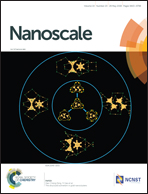Kinetic theory for the formation of diamond nanothreads with desired configurations: a strain–temperature controlled phase diagram†
Abstract
Diamond nanothreads (DNTs) are a brand-new one-dimensional carbon nanomaterial that was synthesized recently by compressing benzene. Compared with sp2 carbon nanotubes, DNTs may possess a much higher interfacial load-transfer ability. However, previous studies have shown that the mechanical properties of DNTs are highly sensitive to the composition of Stone–Wales (SW) transformed sites. Up to now, it remained unclear what roles SWs play in the structure stability and how to engineer its molecular structure for novel mechanical properties. Using ab initio calculations, here we show that the most stable structure of a DNT is composed of alternative SW and hydrogenated carbon nanotube (3,0) units, suggesting that SW plays an essential role in stabilizing DNT. Interestingly, we found that the SW transition barrier is a nearly linear function of the applied strain, enabling strain engineering of its molecular structure. To do so, we propose a strain–temperature–stretching rate phase diagram to guide the construction of desired molecular structures to achieve superplastic behavior of DNTs. Our findings not only enrich our understanding of this novel carbon material, but also provide a strategy to control its structural and mechanical properties for novel applications, such as energy absorption, energy storage and materials reinforcement.



 Please wait while we load your content...
Please wait while we load your content...